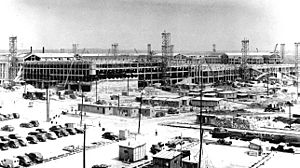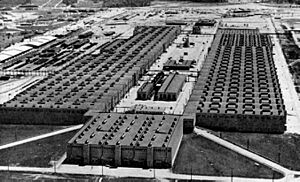Leslie Groves facts for kids
Quick facts for kids
Leslie Groves
|
|
|---|---|
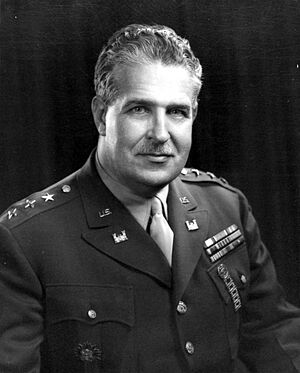
Groves in 1948
|
|
| Birth name | Leslie Richard Groves Jr. |
| Born | 17 August 1896 Albany, New York, U.S. |
| Died | 13 July 1970 (aged 73) Washington, D.C., U.S. |
| Place of burial |
Arlington National Cemetery, Virginia, U.S.
|
| Service/ |
|
| Years of service | 1918–1948 |
| Rank | |
| Unit | Corps of Engineers |
| Commands held | |
| Battles/wars |
|
| Awards |
|
| Alma mater | Massachusetts Institute of Technology United States Military Academy (BS) |
| Signature | |
Leslie Richard Groves Jr. (born August 17, 1896 – died July 13, 1970) was an officer in the United States Army Corps of Engineers. He was a key figure during World War II, known for two huge projects. First, he oversaw the construction of the Pentagon, a massive office building for the War Department. Second, he led the Manhattan Project, a top-secret research effort that developed the atomic bomb.
Leslie Groves grew up in an Army family, moving to different military bases. He graduated from West Point in 1918. Later, he helped survey for a canal in Nicaragua and managed Managua's water supply after an earthquake, earning him a special medal. He was known for being a very determined and hardworking leader. In 1940, he started inspecting construction sites for the Army, and by 1941, he was put in charge of building the Pentagon.
In September 1942, Groves took over the Manhattan Project. He was involved in almost every part of creating the atomic bomb. This included choosing locations like Oak Ridge, Tennessee, Los Alamos, New Mexico, and Hanford, Washington. He managed the huge construction work, made important decisions about how to separate materials, and gathered raw materials. He also directed efforts to learn about Germany's own nuclear plans and helped choose the cities in Japan that would be targets. Groves kept the project very secret, but some spies working within the project managed to share important information with the Soviet Union.
After the war, Groves continued to lead the Manhattan Project until 1947. Then, he led the Armed Forces Special Weapons Project, which managed the military side of nuclear weapons. He retired from the Army in 1948 as a lieutenant general. After his military career, he became a vice president at a company called Sperry Rand.
Contents
Early Life and Education
Leslie Richard Groves Jr. was born in Albany, New York, on August 17, 1896. He was the third of four children. His father, Leslie Richard Groves Sr., was a U.S. Army chaplain. This meant Leslie Jr. spent his childhood living at many different Army posts.
His family moved a lot. They lived in Washington state, Cuba, and the Philippines. They also lived in Minnesota, New Jersey, and Arizona. In 1911, while living in Montana, Leslie met Grace Wilson, who would later become his wife.
Groves went to Queen Anne High School in Seattle, graduating in 1914. He also took classes at the University of Washington. His biggest dream was to attend the West Point. He tried to get in, but didn't score high enough at first. So, he enrolled at the Massachusetts Institute of Technology (MIT). In 1916, he tried again and was accepted into West Point. He later said that joining West Point was his "greatest ambition" because he had grown up in the Army.
Groves started at West Point on June 15, 1916. Because the United States entered World War I in 1917, their training was sped up. He graduated on November 1, 1918, about a year and a half early. Groves finished fourth in his class, which allowed him to join the Corps of Engineers. This was the top choice for many high-ranking cadets.
Between the World Wars
After graduating from West Point, Groves became a first lieutenant in 1919. He traveled to France to see the battlefields of World War I. When he returned, he continued his training as an engineer officer. He was then assigned to the 7th Engineers in Fort Benning, Georgia.
In 1922, Groves married Grace Wilson in Seattle. They had two children: a son named Richard in 1923, and a daughter named Gwen in 1928.
Groves's first overseas assignment was in Hawaii in 1922. He was praised for building a trail there. Later, he worked in Galveston, Texas, helping with shipping channels. In 1927, he was involved in helping with the New England Flood.
In 1929, Groves went to Nicaragua to survey for a possible canal. After a major earthquake hit Managua in 1931, Groves took charge of the city's water supply. For this important work, he received the Nicaraguan Presidential Medal of Merit. He was promoted to captain in 1934. He continued his military education at the Command and General Staff School and the United States Army War College. In 1939, he joined the War Department staff in Washington, D.C.
World War II Efforts
Building the Pentagon
In July 1940, Groves was promoted to major. He became a special assistant for construction to the Quartermaster General. At this time, the U.S. Army was growing rapidly, and there was a huge need to build housing and training facilities for soldiers. The construction program faced many problems like delays and high costs. Groves was brought in to fix these issues. He was known for getting things done quickly and efficiently.
Groves made many changes to speed up construction. He improved communication, demanded regular reports, and made sure payments were processed quickly. He also set priorities for completing parts of the camps so soldiers could move in sooner. By December 1940, the worst of the crisis was over, and facilities for millions of soldiers were nearly finished.
In August 1941, Groves was asked to oversee the construction of a massive new office building for the War Department. This building, designed to hold 40,000 staff members, would become the Pentagon. It was planned to be the largest office building in the world, with twice the space of the Empire State Building.
Groves faced many challenges during the Pentagon's construction, including strikes and material shortages. He worked tirelessly, often six days a week, and visited construction sites on Sundays. The project cost about $63 million, and the first parts of the building were ready for use by April 1942. Groves later joked that he hoped to go to a war zone to find "a little peace."
Leading the Manhattan Project
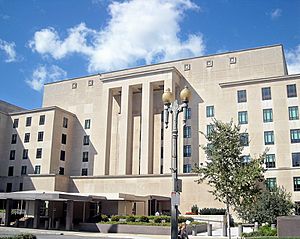
The Manhattan Engineer District (MED) was officially created on August 16, 1942. Its secret mission was to develop an atomic bomb. Groves was chosen to lead this huge project. He was told that if he did the job right, it would "win the war." Groves was promoted to brigadier general before taking command on September 23, 1942.
Groves quickly set up his project headquarters in Washington, D.C. He then traveled to Tennessee to see the site chosen for a production plant at Oak Ridge, Tennessee. Groves was impressed and quickly began the process of acquiring the land.

Groves also met with J. Robert Oppenheimer, a brilliant physicist. Groves was very impressed with Oppenheimer's wide knowledge and ability to understand the challenges of setting up a secret laboratory. In October 1942, Groves and Oppenheimer chose Los Alamos, New Mexico, as the site for the bomb design and testing laboratory. Groves believed Oppenheimer was the best person to lead the laboratory, even though many others disagreed due to Oppenheimer's lack of administrative experience and concerns about his past connections. Groves personally approved Oppenheimer's security clearance. Groves's trust in Oppenheimer proved correct, as Oppenheimer's leadership was crucial to the project's success.
Groves made important decisions about how to separate materials needed for the bomb and how to get raw materials like uranium. He managed to get the highest priority rating for the Manhattan Project, which helped ensure they received the supplies they needed quickly. In 1944, Groves also became chairman of the Combined Development Trust, which bought uranium and thorium ores from around the world.
In late 1944, President Franklin D. Roosevelt asked Groves if atomic bombs could be dropped on Germany. Groves explained that the first working bomb was still months away.
The Manhattan Project was also responsible for gathering military intelligence on Germany's atomic research. Groves created special teams called Operation Alsos to follow advancing armies and collect information and technology from enemy scientists. Despite strict security, Soviet spies managed to steal some of the project's most important secrets.
In March 1944, Groves met with Henry H. Arnold, the head of the U.S. Army Air Forces, to plan how the finished bombs would be delivered. They decided the Boeing B-29 Superfortress bomber would be used. A special group, the 509th Composite Group, was formed to carry out the bombings. A committee chose cities in Japan as targets, including Hiroshima and Nagasaki. Groves was promoted to major general on March 9, 1944.
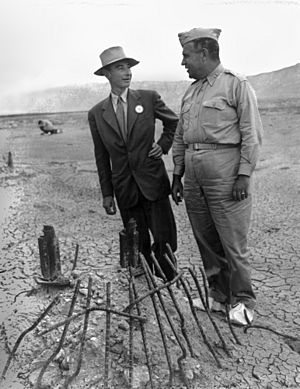
After the atomic bombing of Hiroshima and Nagasaki became public, Groves received the Distinguished Service Medal. This award recognized his incredible leadership in developing the atomic bomb, a project of "unprecedented, world-wide significance."
After the War and Later Life

On January 1, 1947, the responsibility for nuclear power and weapons moved from the Manhattan District to the Atomic Energy Commission. Groves was then appointed chief of the Armed Forces Special Weapons Project (AFSWP), which managed the military aspects of nuclear weapons.
In 1948, Groves decided to leave the Army. He realized that in the smaller postwar military, he wouldn't have a role as important as leading the Manhattan Project. He was given an honorary promotion to lieutenant general just before he retired on February 29, 1948. This was in recognition of his leadership of the atomic bomb program.
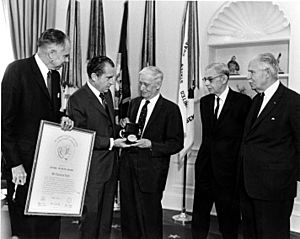
After leaving the Army, Groves became a vice president at Sperry Rand, a company that made equipment and electronics. He retired from this job in 1961 at age 65. He also served as president of the West Point alumni group. In 1962, he presented the Sylvanus Thayer Award to General of the Army Douglas MacArthur, which was when MacArthur gave his famous "Duty, Honor, Country" speech.
Groves wrote a book about the Manhattan Project called Now It Can Be Told, published in 1962. He passed away on July 13, 1970, at the age of 73, due to a heart condition. He was buried in Arlington National Cemetery.
Legacy
Leslie Groves is remembered in several ways. There is a park named after him along the Columbia River near the Hanford Site in Richland, Washington. At the West Point, the LTG Leslie R. Groves Award is given to the cadet with the highest grades in nuclear engineering classes.
Groves has also been shown in many movies and TV shows about the atomic bomb and the Manhattan Project. Actors like Paul Newman and Matt Damon have played him.
See also
 In Spanish: Leslie Groves para niños
In Spanish: Leslie Groves para niños



